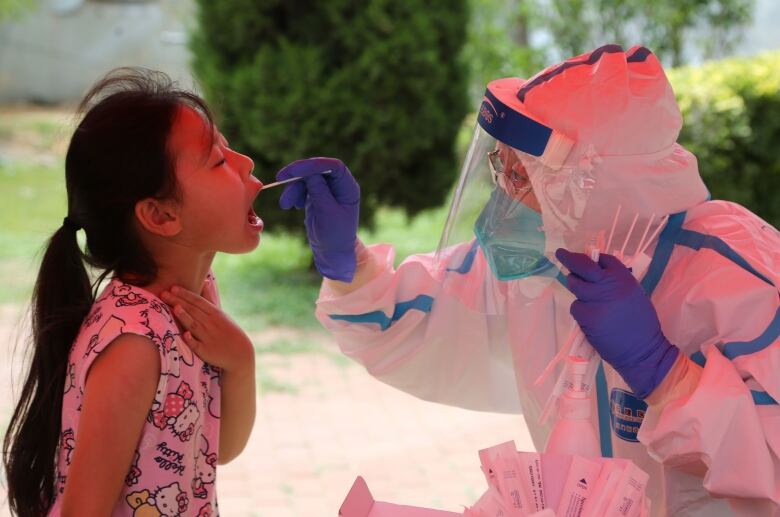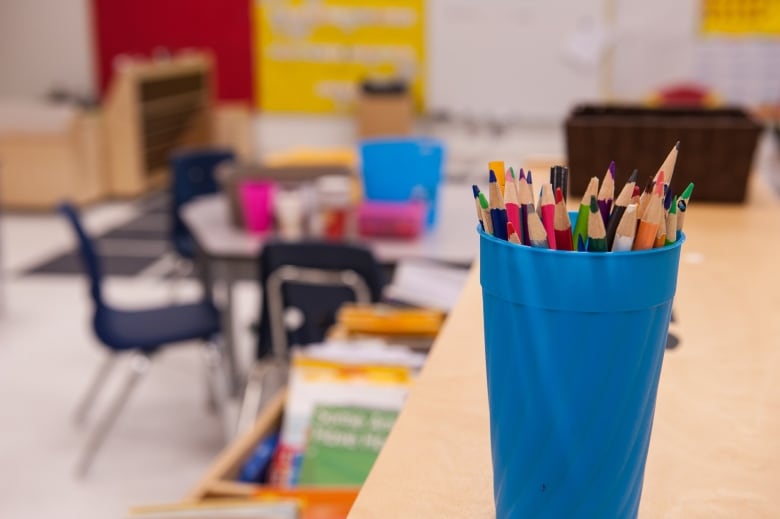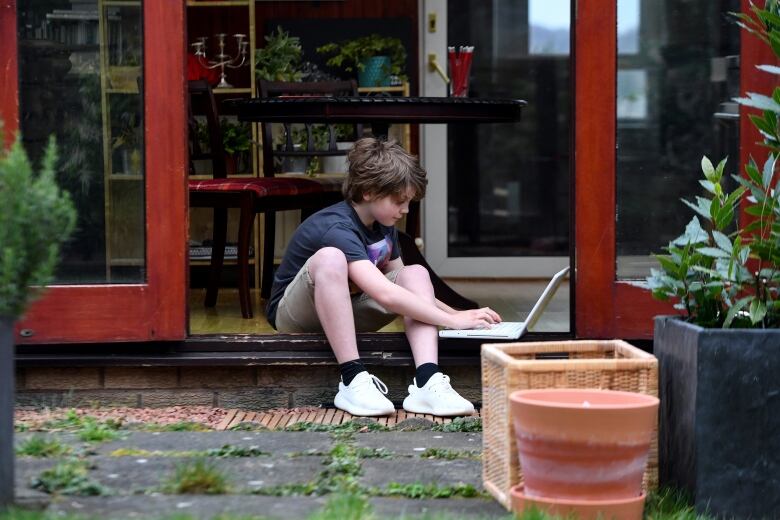Can't decide whether to send your kids back to school? Here's what the experts say
Parents have a difficult choice to make, with scant information and little time

Decision day is looming for many Ottawa parents. Will they send their kids back to school in Septemberor not?
Both English-language boards have said parents may be able to change their mindsbut likely not until at least halfway through the fall.
"To the parents of Ottawa, I hear you," said Dr. Vera Etches, Ottawa's medical officer of health, during a virtual news conference earlier this week.
"This is a difficult decision for many parents, given so many variablesand so many unknowns about the future. There's no right answer for everyone."
Here's some guidance fromEtches and otherexperts.Their comments come from a combination of recent CBC interviews, virtual newsconferencesand publicforums.
What key risk factors should I consider?
The key factors, according to Etches:
- Your child's health conditions.
- Your child's close contacts, and theirhealth conditions.
- Your family's ability to find child care.
- Your family's ability to home-school.
- And whether your child has development needs that require in-class learning with a trained professional.
What are the experts watching for?
Many experts agree a low rate of community transmission is key.
"If it's not in the community, itcan't get into the schools," said Raywat Deonandan,an epidemiologist and associate professorat the University of Ottawa.
"In Ottawa, as of today, I think I'd be confident in opening schools."
WATCH | Why to take acitywide look at cases:
Another expert points to "the three C's."
"In epidemiology and public health, you often talk about the three C's:closed spaces, crowded placesand contact. Andyou know, I just described every public school in Canada," said Dr. Doug Manuel, senior scientistwith The Ottawa Hospital Research Institute.
Still, Manuel said he's planning to send his own kids back to school, addinghe's "encouraged" by some of the measures that will be in place, such as masks and alternating schedules for high school students.
What can we learn from other countries?
"We know there's tremendous possibility of transmission," said Manuel.
Other countries have already sent their children back to school, with mixed results. According to Manuel, we want to be more like Denmark or Finland, and less like Israel.
"In Israel, there were some problems," he said.
There, after initial success in controlling the spread of COVID-19,"they went back to school, got a big heat wave, they couldn't wear their masksand there was a lot of transmission in communities. And they especially had some high schools that were very hard-hit."

Denmark and Finland started sending kids back in the spring, he said, with smaller class sizesand alternating schedules. At the time, Denmark had a similar rate of community transmission to Ottawa's current rate, according to Manuel.
Since then, both Denmark and Finland have been able to maintain low community transmission andare now moving toward a full-time return to the classroom.
"We didn't see a lot of transmission in schools [in those countries].More so in the high schools, less in the ... age 10 and under," Manuelsaid.
He said the jury is still out when it comes to whether kids transmit the virus at a different rate than adults.
"The scientists I speak to, there's quite a lot of uncertainty. People aren't comfortable making a call on that."
Will we see positive cases in schools?
Yes, according to every expert we've spoken to.
"There will be [COVID-19] cases," Etches said this week. "We know that. We can anticipate that."
Will that contribute to a jump in cases in Ottawa? Etches did not offer a prediction, but did say any newcases would likely originate outside the school rather than be transmitted within classrooms and corridors.

Will I need to screen my child for symptoms?
Yes. Every morning. And you should err on the side of caution when deciding whether to keep your kidshome.
Etches saiddetailedat-home screening recommendations will be provided to parents soon. Public health nurses will also be assigned to schools, where"rigorous screening" will be done.
Etches also said parents who keep their kids home because of possible symptoms can expect a follow-up phone call from Ottawa Public Health (OPH).
Experts saidparents should look for more than just respiratory symptoms, since COVID-19 can also cause gastrointestinal symptoms includingnausea, vomiting and diarrhea, particularly in children.
And it's time to let go of the quaint notion that good attendanceequals academic success.
"Keepthem at home if they have symptoms. And you know, I would even go so far as to say if people in your bubble have symptoms, to consider keeping your kids home," said epidemiologist Dara Spatz Friedman.

What's with these'isolation rooms'?
School boards are trying to figureout what to do with students who display symptoms while at school. Boards said they're looking to OPH for guidance on this.
"We talk about having isolation spaces if a child should become sick, or be seen to be sick, during the school day," said Camille Williams-Taylor, director of education with the Ottawa-Carleton District School Board (OCDSB).
She said planning is in the initial stages, and more information will be communicated to parents in the coming weeks.
What happens if someone at school tests positive?
Etches said earlier this week that positive test results in schools will be looked at on a case-by-case basis.
She also said there will be "response teams" with officials from both OPH and the school board deployedto "make sure that the actions that need to be taken, are taken."
She defined an "outbreak"as "two cases in a school where there's a link between them," as opposed to two cases that originated separately outside the school.

The Ottawa Catholic School Board(OCSB) said it's waiting to hear from the Ministry of Education on what will happen ifa single student tests positive.
"We expect that any day now, and it will have the very key logistics of who needs to be tested, how long each student or staff needs to be out of the building, what are the procedures for the return," said Tom D'Amico, director of education at the OCSB.
Does this burst the idea ofbubbles?
"You might throw up your handsand say, 'Well, what's the point of a bubble if my kid is in school?'" said Friedman.
But going back to school doesn't mean it's time to stop bubbling, according toher and other experts.
"The kids in your kid's classroom are not part of your bubble, [so] there should be physical distancing," she said.
Etches also appealed to adults this week to keep their contacts to a minimum. "Adults are likely the source for children bringing it into the school," she said.
CHEO emergency room doctor Dayna Bell advisedparents who are sending their kids back to schoolto have frank discussions with the other adults in their bubbles.
"You need to be able to say to that person, 'Hey, if my child picks up COVID at schooland they give it to you, and you end up hospitalized, are we still going to be friends?" Bell suggested.
"Because if that situation isn't acceptable, then you know you can't be in a bubble together."
Is going back to school better for my child's mental health?
Dr. Catherine Horvath, a child psychologist, said she's concerned that children who suffer from anxiety, depression or learning issues will find it increasingly difficult to return to school the longer they stay home.
She said since schools closed in March, her young patients have reported a decrease in anxiety because "there's such a decrease in demands and expectations and things that make them anxious."
She said parents should broach the subject the same way they would approach a sex talk: make it age-appropriate, give only the facts and let them ask questions.
"We need to remember that a lot of that is our stressand not our children's stressunless we make it their stress," she said.
Horvath said children who don't typically struggle with anxiety couldbenefit from returning to class, and said that's what she plans to do with her own kids.
Are school boards considering alternative classrooms spaces?
School boards said they're hoping to keep the learning environment as "familiar" as possible.
"There are operational challenges with moving spaces," said Williams-Taylor, adding that transporting students to locations outside the school would pose too great a challenge.
"We certainly are not looking to move to spaces that are outside of the school."
Will online learning be better than it was in the spring?
Online learning in the spring was an "emergency pivot," said Michelle Schira Hagerman, an assistant professor atthe University of Ottawa's Faculty of Education.
"I'm confident the online instructional modality will feel a little bit more predictable, a little bit more measured. There are systems now in place that weren't necessarily in place at scale when we had to pivot in March," she said.
The OCDSB said "clear schedules and clear expectations" will be in place with online learning.
"Having students understand when their tests are going to be, what the assessments are going to look like, is going to be certainly one of the other differences that we will see with online," saidCamille Williams-Taylor, director of education with the OCDSB.
The Catholic board said it does not anticipate live-streaming classes.
"One of the things that our teachers unions have indicated to us in our dialogues is they do not want the classroom teacher responsible at the same time for instructing and supervising students at homeand those in front of them," said Tom D'Amico with OCSB.
Can my children still see their grandparents if I'm sending them back to school?
Experts say this is an individual decision that dependson comfort levels and health status.
At least one epidemiologist we spoke with said he wouldn't be comfortable with it.
"I don't think I would at this point," said Deonandan. "Again, it all variesdepending on the nature of the community load. If suddenly we're getting one or two cases per week in the community, then my confidence level goes up tremendously.
"But if we're in double digits per day, I'm confident about opening schools, but not around exposing my parents to potential lethal infection. So I'd be hesitant, but it doesn't mean that they can't visit the child, if the appropriate protections are in place, like face shieldsand face masks and distancing."
Is there reason to be optimistic?
Deonandan, who describes himself as an optimist, has a mantra to share.
"Don't let perfect be the enemy of good," he said."We can deploy important strategies, and they may not work perfectly. But if enough of them workmost of the time, then we have sufficient protection.
"It's like building fortifications against an invading army. You could build your castle, you could build your moat, you can build a big door, but either one of those things is not going to be perfect. But all of them in series may provide sufficient protection.
"So the mask wearing won't be perfect. Kids will fidget. That's fine. Plexiglas barriers between desks won't be perfect. Sometimes kids will look over them but all those things, layered on top of each other, should offer sufficient protection," he said.
WATCH | Combining measures to widen protection















_(720p).jpg)


 OFFICIAL HD MUSIC VIDEO.jpg)
.jpg)



























































































